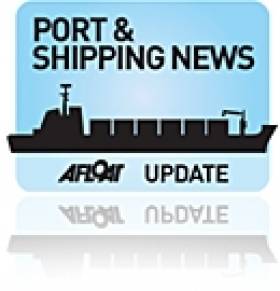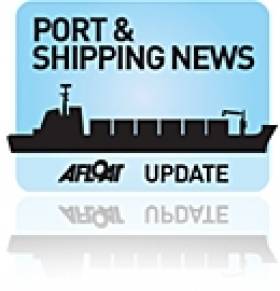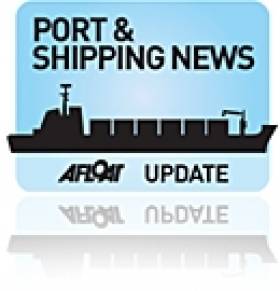Displaying items by tag: Guinness St James Gate Brewery
Snow Flurry Send off as Guinness Tank Cargoship Sets Sail
#GuinnessTankShip – Amidst snow flurries and gusts up to 34 knots, cargoship Blue Tune departed Dun Laoghaire Harbour today, having discharged a final round of fermentation tanks yesterday for Guinness, writes Jehan Ashmore.
The vessel registered in St. John's in Antigua and Bermuda, was the third vessel to dock in Dun Laoghaire Harbour since mid-February. These vessels represented the return of cargo ship activity, a trade not witnessed in the port for more than two decades.
Combined the 'project' cargo consisted of three batchs of large stainless steel fermentation tanks weighing up to 30 tons each. They are to be installed as part of a €153m plant upgrade at the Guinness St. James's Gate Brewery facility close to central Dublin.
As the 3,845 tonnes Blue Tune headed out through the harbour mouth she set a course for the North Burford Buoy and then the 2010 built vessel veered for the Kish Bank bound for Cardiff.
At the same time Stena Line's HSS Stena Explorer was making an inbound sailing from Holyhead having rounded the South Burford Buoy.
#GuinnessTankship - The 86m cargsoship Blue Tune (2010/3,845grt) docked in Dun Laoghaire Harbour last night is undertood to have arrived with the final batch of fermentation tanks bound for the Guinness St. James Gate Brewery in central Dublin, writes Jehan Ashmore.
In heavy seas and strong south-easterly gale force winds, Blue Tune made the short passage across the bay from Dublin Port, having firstly delivered a part-cargo from Rotterdam.
Unlike the previous deliveries of the tanks to Dun Laoghaire Harbour taken on board two Dutch-flagged vessels, firstly by Myrte (2008/6,120grt) in February followed by Keizersborg (1996/6,142grt) last month, on this occasion Blue Tune is flagged under Antigua and Bermuda.
In addition Blue Tune is smaller compared to her Dutch counterparts in terms of tonnage size which would also place her as a 'coaster' compared to much larger vessels calling to Dublin Port and in this recent 'project' cargo trade to Dun Laoghaire Harbour.
As with the other Guinness related cargo-calls, Blue Tune berthed at the former 'mail' boat at Carlisle Pier, where six stainless steel fermentation tanks are due to be unloaded within the next few days.
Likewise forward tank transportation from Dun Laoghaire to the brewery which is undergoing a major €153m upgrade, is to be undertaken by road convoy and expected to be carried out in a night-time operation.
Guinness Tanks Face Final Leg from Harbour to Gate
#GuinnessTanks – As previously reported on Afloat.ie, the huge fermentation tanks that arrived at the weekend to Dun Laoghaire Harbour, were today unloaded from the cargsoship Myrte, writes Jehan Ashmore.
The 25m long tanks made of stainless steel, and each weighing 30 tons, were shipped from Rotterdam by the Dutch flagged 6,120 tonnes vessel.
A key factor as to why the general cargoship docked in Dun Laoghaire Harbour rather than Dublin Port, was due to 'logistics', according to shipping agents Celtic Forwarding Ltd.
As the tanks were discharged by two cranes, they were lowered onto the truck-trailers on Carlisle Pier. The final leg of the journey will be undertaken during a night-time operation to Diageo's Guinness (St. James Gate) Brewery.
The 'wide-load' will be carried out in one single convoy or in several transits to the historic city-centre brewery, which is undergoing a major €153m investment programme.


























































